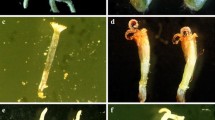Summary
-
1.
The data show that a lower percentage of staminate plants is due to the lack of a proper amount of volatile oils left in the pollen before pollination.
-
2.
By the use of pollen sprayed with volatile oil the percentage of staminate plants was increased by about 26·1±1.
-
3.
The data show that it is the presence or absence or abundance of volatile oil in the pollen which modifies the normal ratio of staminate and pistillate plants, and not the increase or decrease of water content. If water has any significance in the ratio, it is very small (±4 per cent.).
-
4.
It is possible by this method to increase the percentage of staminate plants over that of pistillate ones, at least in the Mary Washington strain of asparagus.
Similar content being viewed by others
References
Anonymous (1924). “Improving Delta asparagus.”Pacific Rural Press,CVII, 302 March 1st.
Anonymous (1925). “Asparagus rust threatens.”Ibid. Pacific Rural Press CX, 10, July 4th.
Bailey, J. S. (1928). “The effect of apple blossom removal on flower bud formation.”Proc. Amer. Soc. Hort. Sci. XXV, 198–201.
Bond, C. J. (1927). “The influence of pollen maturity and restricted pollination on the simple Mendelian ratio in the pea.”Journ. Gen. XVII, 269–81.
Borthwick, H. A. (1924). “Factors influencing the rate of germination of the seeds ofAsparague officinalis.” University of California Publications, Agric. Exp. Sta. Tech. Paper,XVIII.
Böttner, J. (1921).Praktischer Lehrbuch des Spargelbaus, pp. 1–22.
De Fabery, S. L. (1916). “Control of asparagus rust.”Country Gentleman,LXXXI, 165, September 9th.
Fisher, R. A. (1925).Statistical Methods for Research Workers. Oliver and Boyd, London.
Green, W. J. (1890). “Asparagus.”Ohio Agric. Exp. Sta. Bull. IX, 2nd series, 3, 241–4.
Hooker, H. D. (1925). “Investigations by American Horticulturalists on carbohydrate nitrogen relations.”Journ. Pom. and Hort. Sci. V, 34–42.
Houben, J. (1921).Die Methoden der organischen Chemie, 2nd ed., p. 582. George Thieme Co., Leipzig.
Jones, H. A. andRobbins, W. W. (1924). “Growing and handling of asparagus crowns.”Calif. Exp. Sta. Bull. CCCLXXXI.
Kraus, E. J. andKraybill, H. R. (1918). “Vegetation and reproduction with special reference to tomato.”Oregon Exp. Sta. Bull. CXLIX.
Kraybill, H. R. (1923). “Effect of shading and ringing upon the chemical composition of apple and peach trees.”Neu Hamp. Exp. Sta. Tech. Bull. XXIII, 3–27.
Murneek, A. E. (1927). “Fruit thinning in Missouri.”Mo. Exp. Sta. Bull. CCLII, 1–315.
Norton, J. B. (1924). “The story of Mary Washington.”Market Grower's Journ. XXXIV, 229–30, March 15th.
Paddock, W. andCharles, F. G. (1928). “The effect of apple blossom removal upon bud formation and differentiation.”Proc. Amer. Soc. Hort. Sci. XXV, 195–7.
Perry, E. J. (1911). “Volatile or essential oils.” InAllen's Commercial Organic Analysis, 4th ed.,IV, 217–24. P. Blakiston's Son and Co.
Robbins, W. W. andJones, H. A. (1925). “Secondary sex characters inAsparagus officinalis L..”Hilgardia,I, 183–202.
— (1926). “Sex as a factor in growing asparagus.”Proc. Amer. Soc. Hort. Sci. XXIII, 19–23.
— (1928). “Further studies on sex in asparagus.”Ibid. XXV, 13–16.
Robbins, W. W. (1926). “Varieties of asparagus.”California Countryman,XII, 7, January.
Roberts, R. H. (1920). “Off year apple bearing and apple spur growth.”Wisc. Exp. Sta. Bull. CCCXVII, 1–35.
Sears, P. B. andMetcalf, E. (1926–7). “The behaviour of pollen starch in a Geranium and its bud sport.”Journ. Gen. XVII 33–42.
Thompson, H. F. (1923). “Asparagus notes.”Market Grower's Journ. XXXII, 92.
Tiedjens, V. A. (1924). “Some physiological aspects ofAsparagus officinalis.”Proc. Amer. Soc. Hort. Sci. XXI, 129–40.
Walker, J. (1913).Introduction to Practical Chemistry, 7th ed., pp. 84–7. Macmillan and Co.
Wheeler, W. (1922). “Washington asparagus strains.”Market Grower's Journ. XXX, 140, March 1st.
Author information
Authors and Affiliations
Additional information
(With Five Text-figures.)
Rights and permissions
About this article
Cite this article
Malhotra, R.C. The sex ratio inAsparagus officinalis L. and its artificial modification. Journ. of Gen. 23, 157–172 (1930). https://doi.org/10.1007/BF03052606
Issue Date:
DOI: https://doi.org/10.1007/BF03052606




